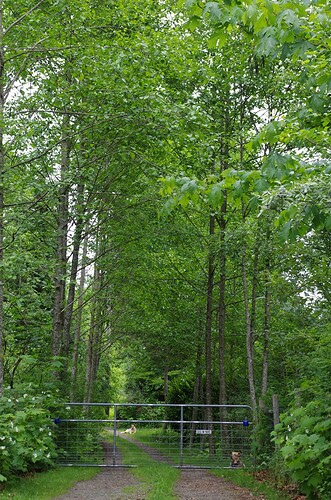In celebration of the Year of the Garden, and National Garden Day on June 18, the CVHS recently challenged its members to reflect on “what our gardens mean to us”. Here is the first entry, from Heather and John, who have a wonderful paradise that they have been creating out of their piece of wilderness…
Pandemic Celebration Garden
During 2020 and 2021 we added to the landscape of our large pond by building a fountain, and two streams that fall into our new “serenity pond” and flow under a bridge into a kiddies wading pool. The wading pool is connected back to the large pond. Water for the fountain is pumped up from the large pond.


Red Celebration Garden
We have planted a number of flowers and trees and encourage others to grow naturally to remind us of Canadian places we know. The list includes:
- shooting stars (AB)
- trillium (Ont and BC)
- wild rose (AB)
- Nootka Rose (BC)
- tiger lily (Sask)
- fireweed (Yukon)
- prairie crocus (Manitoba)
- iris (QUE)
- dogwood (BC)
- sugar maple (Canada)
- hawthorn (Manitoulin Island Ont.)
- and the list goes on…

Climate Action Celebration Garden
Well, okay we do not really celebrate climate action (given that we have worked on it for 30 years or more), but our garden does help to balance the greenhouse gasses in the Carbon Cycle.
Our acre of lush grass fixes CO2 from the air into the soil. For every kg of grass clippings, we create at least a kg of Carbon fixed in the soil as organic matter. This also helps the grass by allowing the soil to better store nutrients and water for the grass to use.
Our land was clearcut about 20 years ago and we have encouraged the regrowth of the Douglas fir, cedar, hemlock and alder forest. The young trees and ground cover also store carbon from the air. We note too that the salal which is prevalent in the 3 acres of forest here, acts just like grass in that it fixes carbon from the air into the soil, building up soil organic matter.
Finally, we installed a solar power system here to generate all our electricity. We decided on this for economic as well as environmental reasons.


Therapeutic Garden.
Our gardens are indeed great for the body and soul. We have created several locations to sit and enjoy including the “serenity pond”, gazebo at the large pond, pavilion at the rose and dahlia garden and the deck overlooking the orchard, lawns and fire pit area. They are all great places to chill, watch and listen to the diversity of bird life here, hear the water flow, feed the fish, watch the ecosystems working as they should, sip wine and drink beer on hot days or just do a “walkabout”.
The gardens also keep us physically fit (more or less) as we use push mowers on the 1 acre of grass, twice a week. In between there is the ongoing weeding, planting and harvesting to stay active. Summer time swimming in the big pond is a bonus we always enjoy.


Edible Celebration Garden.
One of the first gardens we constructed was the veggie patch and homemade greenhouse. In total we have 1,000 sq ft of growing space with a foot of well drained sandy loam soil. The highly productive soil allows us to harvest enough tomatoes, potatoes, cauliflower, broccoli, corn, peas, lettuce, beans, garlic, onions, beets and carrots to last a year until the next crop is ready. Great complements of fresh homegrown veggies to go with beef, chicken pork and fish for dinner.


Native Plant Celebration.
Our gardens are in a clearing in regrowing (about 20 years old) Douglas fir forest (fir, pine, cedar, hemlock). We encourage the garden areas to blend into the forest, the edges marked by the fresh shiny leaves of salal, bracken fern, huckleberry, fireweed, thimbleberry and not so native blackberry. We revel in the native dogwood, red current, holly, Oregon grape and ocean spray that are present, and feel sad when many of the young western white pine die of the fungus disease they are prone to. They, and the alder and cottonwoods become firewood for us when they are big enough.
During construction of the house and landscape we saved what little forest topsoil there was and replaced it during the reconstruction of the landscapes here. Hence, we have moss, lichens, and many native wildflowers growing around the large pond where the forest soil was replaced.


Social Celebration Garden.
Our gardens have lots of open space, and activities to entertain friends and family. Prior to 2020 we hosted a Canada Day celebration for 30 or 40 people. They enjoyed gathering at the large pond, swimming, canoeing, feeding koi, cooking burgers and hot dogs, relaxing in the sun, and sitting around the fire pit in the evening marveling at the diving night hawks. Many friends and family return frequently to enjoy the gardens. Little kids and big kids can also have fun in the tree fort or at the horseshoe pit. Some also enjoy catching tadpoles and bullfrogs around the big pond.


Personal Celebration Garden.
We call our place Hastie Haven in celebration of our retirement from long and successful careers primarily in Alberta. We celebrate not having to live with 6 months of winter and trying to garden in 90-day summers.
The construction and enjoyment of our gardens from a clearcut forest landscape is, in a sense, a continuation of my 45-year career in land reclamation where I helped rebuild natural and useful landscapes on an industrial scale throughout western and northern Canada.
We are proud to call the gardens home and a haven that we can enjoy!






